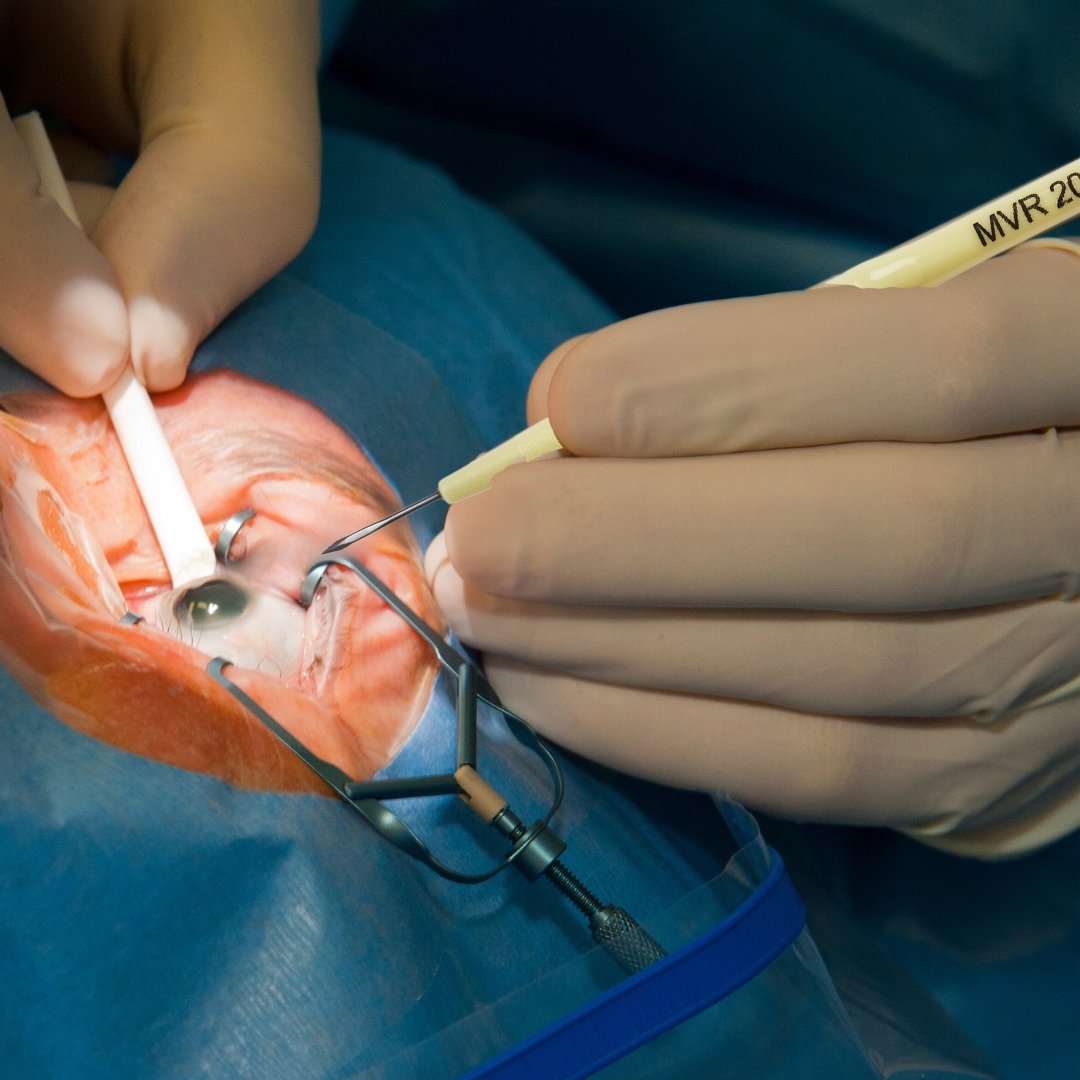The Micro Vitreoretinal (MVR) blade, a specialized instrument designed for difficult eye procedures, Given the delicate structure of the eye, ocular surgery requires precision and accuracy. The one of the most critical tools surgeons utilize to ensure precision. MVR blades are notably effective in retinal and vitreous procedures, where even slight incisions and motions can considerably improve patient recovery and results. Because of their ability to aid in accurate cuts, they have become an integral component of modern ophthalmic instruments.
These blades offer unparalleled sharpness and control, allowing surgeons to perform minimally invasive treatments with less tissue harm. This results in speedier healing times and improved patient outcomes. MVR blades, whether used in vitrectomy, cataract surgery, or retinal therapies, give the precision needed in ophthalmology. This article will explain the importance of MVR blades in eye surgery, including their various types, benefits, major selection criteria, and best practices for using these critical ophthalmic instruments.
Importance of MVR Blades in Ophthalmic Surgery
MVR blades are essential in ocular surgery, particularly for retinal and vitreous treatments. These precision-engineered Ophthalmic surgical instruments enable surgeons to make exact incisions and cuts while causing minimal damage to the eye’s sensitive components. MVR blades give the precision required for challenging procedures including vitrectomies, retinal detachment repair, and cataract extractions. Their design allows access to the eye’s posterior part while maintaining control and reducing tissue stress.
MVR blades’ sharpness and exceptional craftsmanship make them ideal for minimally invasive operations, which are critical for shortening recovery times and improving patient outcomes. Their ability to ensure precise, controlled incisions makes them essential for current ophthalmic operations. Without these specialized devices, executing delicate microsurgeries with the needed accuracy would be much more difficult, thereby increasing the risk of complications. Thus, MVR blades are an essential component of the Ophthalmic surgical instrument toolset, critical for attaining optimal surgical outcomes and patient care.
Types of MVR Blades
MVR blades are available in a range of designs, each tailored to meet specific surgical requirements. The most often used types are:
Straight MVR Blades: These blades feature a straight edge, which allows for precise and clean cuts. They are commonly used to create entrance holes or ports in the sclera for procedures like vitrectomy.
Curved MVR Blades: These blades are meant to match the natural curvature of the eye, making them great for accessing hard-to-reach areas. They are especially useful for surgeries that need curved incisions, providing greater maneuverability and precision.
Angled MVR Blades: Angled MVR blades have a slight angle at the tip, which improves control and visibility, especially in challenging surgical angles. This design allows surgeons to better access problematic regions of the eye.
Surgeons choose the appropriate MVR blade depending on the surgical procedure and anatomical characteristics of the patient’s eye, ensuring the greatest possible results and precision with each surgery.
Advantages of Using MVR Blades
Using MVR blades in ocular procedures has numerous notable benefits:
Precision: MVR blades are designed to produce clean, precise micro-incisions. This precision minimizes tissue damage, resulting in faster healing and better surgical outcomes. Their painstaking design allows for precise modifications, even at the tiniest scale.
Versatility: These ophthalmic blades are essential for a wide range of eye surgeries, including vitrectomies, corneal procedures, and cataract surgeries. Their adjustable design makes them suited for a wide range of surgical applications, increasing efficiency and functionality.
Minimal Invasiveness: The sharpness of MVR blades allows for very small incisions, reducing eye trauma. This decreased invasiveness reduces the incidence of postoperative consequences including infections or inflammation, which improves overall patient safety.
Improved Healing: MVR blades improve healing by producing smaller, more precise cuts, resulting in faster recovery times and reduced discomfort following surgery. The careful construction of these specialist ophthalmic blades benefits patients by allowing for a speedier recovery period and improved overall surgery outcomes.
MVR Blade Selection and Considerations
Choosing the appropriate MVR blade is critical to the effectiveness of ophthalmic treatments. Here are crucial considerations for picking the best suitable blade:
Surgical Procedure: The type of eye surgery you are undergoing has a significant impact on the blade choice. Straight MVR blades are commonly used to make scleral incisions, whereas curved blades are better suited for treatments that need navigation along the natural curvature of the eye.
Blade Size: MVR blades are available in a variety of sizes, including MVR 20 and MVR 25 gauge. The right size should be chosen based on the incision needs and anatomical characteristics of the patient’s eye.
Material and Quality: High-quality stainless steel blades are recommended for their longevity and resistance to dulling. Making accurate, clean incisions during surgery requires a sharp, defect-free blade.
Sterility: Because ocular procedures are so delicate, it is critical to utilize sterile, single-use MVR blades to avoid contamination and infection. Proper hygiene and handling standards contribute to the safety and efficacy of the surgical procedure.
Handling and Care for MVR Blades
MVR blades must be properly maintained and cared for to work and give satisfactory surgical results. Here is how to correctly use these blades:
To limit the risk of infection, use sterile, pre-packaged MVR blades. Before using reusable blades, ensure they have been completely sterilized by medical guidelines. Adherence to strict sterilization processes is critical for preventing infection.
To prevent damage or dulling, keep MVR blades dry and sterile. Improper storage or use can result in blade defects, reducing their utility and jeopardizing the surgery’s success.
MVR blades should be handled with care to maintain their sharp cutting edge. To guarantee that the blade functions well during the procedure, use proper loading and placement techniques. To maintain the blade sharp, avoid contacting the cutting edge.
Following these criteria allows surgeons to guarantee that MVR blades are still effective and safe to use, improving the quality of ocular surgeries and lowering patient risks.
Conclusion
MVR blades are crucial tools in ophthalmic surgery, known for their precision, adaptability, and low tissue stress. These advanced eye surgery blades are critical for obtaining the high levels of precision required in delicate treatments. Their different designs enable surgeons to select the best blade for each treatment, resulting in improved performance and surgical outcomes. Ophthalmologists may conduct sensitive eye surgeries with greater precision by using the right MVR blade and correctly maintaining it, resulting in shorter recovery times and improved patient results.
Using high-quality Eye Surgical Blade in surgical practice is crucial for maintaining care and accuracy in modern ophthalmic procedures. As medical technology advances, MVR blades will remain a cornerstone in the area of eye surgery, helping to improve surgical techniques and patient outcomes. Their ongoing development and improvement promise to improve the precision and efficacy of eye procedures in the future.
Shah Eye Care, a leading ophthalmic instruments company in India specialized in manufacturing ophthalmic microsurgical knives. Offering top-notch products and customized solutions through contract manufacturing and private labeling.












